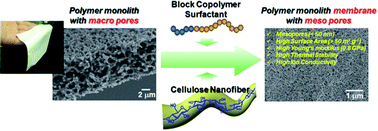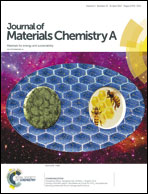Fabrication of surface skinless membranes of epoxy resin-based mesoporous monoliths toward advanced separators for lithium ion batteries†
Abstract
In this article, we propose a versatile method to prepare epoxy resin-based monolith membrane without any surface skin layer through polymerization induced spinodal type phase separation using a poly(vinyl alcohol) sacrificial film, where the monolith is a porous material with a bicontinuous skeletal structure. The resulting monolith membranes exhibit well-defined pore sizes, and high mechanical strength, thermal stability, and ionic conductivity in liquid electrolytes. A block copolymer has been applied to control the pore size to be at the mesoscale, and surface skinless freestanding monolith membrane have been developed. To improve the mechanical properties, cellulose nanofibers are introduced as a reinforcing filler. The monolith membranes are thermally resistant at least up to 200 °C. The ionic conductivity of the monolith membranes (0.71 mS cm−1 at 25 °C) is comparable to those of commonly used polyolefin separators. The results that are presented here demonstrate that polymer monolith membranes have bright prospects as novel separators for lithium ion batteries, fuel cells, etc.



 Please wait while we load your content...
Please wait while we load your content...